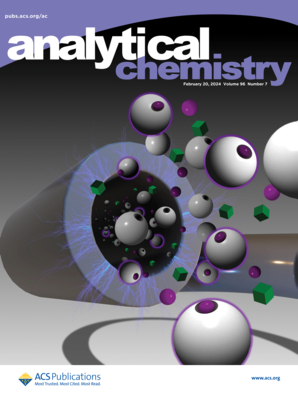Optimization of Collagenase Proteomics for Improved Mass Spectrometry Imaging Peptide Identification
IF 6.7
1区 化学
Q1 CHEMISTRY, ANALYTICAL
引用次数: 0
Abstract
The extracellular matrix (ECM) is composed of a dynamically regulated collagenous scaffold that provides structure, conveys cellular and environmental communication, and contributes to disease progression. Collagen proteins derived from clinically archived formalin-fixed, paraffin-embedded (FFPE) tissues are analytically challenging due to dense post-translational modifications, high proline content, and insolubility. A recent advancement in ECM proteomics is the use of collagenase type III, an ECM-specific bacterial protease, to target native collagenous structures on-tissue for peptide imaging. The resulting collagenase-generated peptides have biochemical differences compared to tryptic peptides, creating analytical challenges in elucidating peptide sequence information. In this study, we characterize collagenase as a proteomic enzyme for ECM-targeted liquid chromatography trapped ion mobility spectrometry tandem mass spectrometry (LC-TIMS-MS/MS) and matrix-assisted laser/desorption ionization mass spectrometry imaging (MALDI-MSI) proteomic workflows. We then optimized collagenase-generated peptide sequencing for MALDI-MSI peptide identification from clinically archived FFPE tissue sections. Soluble rat tail collagen solution is used as a collagen standard to elucidate tryptic and collagenase cleavage sites within collagen. Proteomic readouts of FFPE tissue are compared across trypsin and collagenase digests to assess for ECM enrichment by collagenase in biologically complex samples. Optimized methods for MALDI-MSI peptide identification are comprehensively detailed from sample preparation to MS data acquisition and MS data analysis for reproducible implementation. On-tissue digestion followed by liquid surface extraction (LSE), inclusion of singly charged peptides during data acquisition, and implementation of nonspecific cleavage during database searching resulted in the most collagenase-generated peptide spectrum matches as well as MALDI-MSI peptide identifications. This research establishes parameters for the optimal identification of peptides from collagenase-directed ECM proteomic workflows for targeted spatial analysis of the ECM.

求助全文
约1分钟内获得全文
求助全文
来源期刊

Analytical Chemistry
化学-分析化学
CiteScore
12.10
自引率
12.20%
发文量
1949
审稿时长
1.4 months
期刊介绍:
Analytical Chemistry, a peer-reviewed research journal, focuses on disseminating new and original knowledge across all branches of analytical chemistry. Fundamental articles may explore general principles of chemical measurement science and need not directly address existing or potential analytical methodology. They can be entirely theoretical or report experimental results. Contributions may cover various phases of analytical operations, including sampling, bioanalysis, electrochemistry, mass spectrometry, microscale and nanoscale systems, environmental analysis, separations, spectroscopy, chemical reactions and selectivity, instrumentation, imaging, surface analysis, and data processing. Papers discussing known analytical methods should present a significant, original application of the method, a notable improvement, or results on an important analyte.
 求助内容:
求助内容: 应助结果提醒方式:
应助结果提醒方式:


